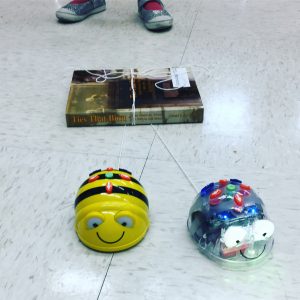Coding + Engineering = The perfect pairing
Look Familiar?
So here's the thing...engineering in early childhood may sound fancy, but it actually isn't a new concept. Remember that thing called "junk modeling"? You know, the center you have with toilet rolls, boxes, pipe cleaners, tape, scissors, and a bunch of other junk materials that you let your students construct with? Yea...we call that Engineering now (ha!). There is a slight difference though, there are many cooler materials involved, including the integration of things like circuitry, and robotics. We are also teaching children to go through stages in the engineering design process such planning, testing, and improving. No matter which engineering design cycle you may be drawn to, they all hold similarities. Here is the one we use at our school from PreK-8. In high school, the cycle gets a bit more complex but this is still the core foundation.
The Gift of Boredom
Bee Bots have been a part of our robotics program at Taipei American School (TAS) even before I arrived four years ago. I brought Blue Bots into the mix two years ago, and although they offered more functionality through the use of the app, they taught very similar skills and were capable of similar things to the Bee Bot. After four years using these robots as both a classroom teacher and a Technology and Design Coach, I started to get bored. Our Pre-K and Kindergarten grades recently acquired a set of Big Blue Blocks and I got the idea to try and use them to build more complicated, three dimensional paths/mazes for the Blue Bots. I quickly learned however, that Bee Bots and Blue Bots do NOT go up any type of incline (at least not without picking them up first). Then it dawned upon me, I had a problem that my students could help me solve using the engineering design cycle!
How can we help the Blue Bots and Bee Bots get to higher surfaces?
I showed the students how the idea of a ramp just didn't work, and then prompted them to think about how we get to different floors in a building if we couldn't use the stairs. The answer: an elevator
Engineering = Problem Solving
My Kindergarten students agreed that using the Bee Bots and Blue Bots would be so much more fun if we could create multi-leveled mazes and paths for them. So, they were naturally drawn to the challenge of solving this particular problem. Allow me to first define what we meant by "elevator". I wasn't asking 5 year-olds to create a pulley system on their own, it would basically be an elevator operated by a human arm. :)
The requirements for the elevator were:
- To be big enough for the Bee/Blue Bot to fit into
- To be strong enough to carry the weight of the Bee/Blue Bot
- To be safe so that the Bee/Blue Bot did not fall off
- Able to operate using just one hand (added bonus if the first three were completed)
As all engineers do, the students began by sketching a plan. I laid out all the materials that I had available for them and they used those as a guide for ideas of what they could use in their plan. Here is an example:
Naturally as they began to build, they discovered where their original plans failed and made adjustments accordingly. Most students went through at least 2-3 iterations of their design by going through the cycle of testing and improving. Here is an example of an elevator that was built and tested. The girls creating this realized that the plate wasn't allowing the Blue Bot to get onto or off of the elevator independently, so they share how they will edit their design.
Figuring out the Program
That wasn't the end of the challenge! Now that they had successfully built a strong and safe elevator for the Bee/Blue Bot, they now had to create a maze using the Big Blue Blocks AND figure out the program to get their Bee/Blue Bot through it using the elevator. Here are some things that I did to keep the process manageable:
- I purposely chose the blocks they were allowed to use (blocks with flat surfaces an no holes on those surfaces)
- Each group was allowed to use a maximum of 3 blocks to create this maze, many only used two.
- Gaps between the blocks were allowed, that's where the elevator could come in to help
The programming process was tricky, students had to figure out things like:
- How many steps forward or backward, a Bee/Blue Bot needed to take to get across particular blocks
- How to use the "pause" command to make the Bee/Blue Bot wait while in the elevator
- If there were gaps, students needed to pick up the Bee/Blue Bot using the elevator and carry it over to the next block. Often this meant the Bee/Blue Bot would need to continue the journey moving backwards.
It wasn't perfect, the Big Blue blocks, do not connect together seamlessly, so whenever one of the Bee/Blue Bots were crossing over from one block to the next, it often needed a little nudge so it wouldn't get stuck in the small gap. They also realized that when picking up a Bee/Blue Bot off a block, they needed to place their elevator slightly lower than the surface so that the Bee/Blue Bot would fall onto it. Even then, the robots often needed a nudge (hehe). At the end however, I was extremely impressed with the problem solving, and thinking that the students went through to figure out the program and adapt it as they found out where the bugs in their program were! Here are a few examples of completed programs:
Extended Thinking
After this project, my students began to have their own questions about the Bee and Blue Bots. Some students wondered if they could solve the problem of the gaps between Big Blue Blocks, so that the path could be a smooth one. Other students wondered more about the robots themselves and asked questions like how much weight could they pull. I decided that it was a great opportunity for students to investigate their own inquiries and extended the project. Here are a few:




